 Table of content What its all about The ascending guitarist will find everything necessary in this book, to come to an broad understanding of the fretboard of the guitar. It is highly recommended to be familiar with the basics of guitar playing, before working with this book. For the advanced beginner although, this book opens new doors and unlocks amazing ways to perceive the fretboard.
Table of content What its all about The ascending guitarist will find everything necessary in this book, to come to an broad understanding of the fretboard of the guitar. It is highly recommended to be familiar with the basics of guitar playing, before working with this book. For the advanced beginner although, this book opens new doors and unlocks amazing ways to perceive the fretboard.
| You are an advanced beginner, when you can play these basic chords fluently: C Major, A Major, A Minor, G Major, E Major, E Minor, D Major, D Minor. |
Im gonna show, how you can master the fretboard by moving this chords and which scales you can use.
| To transpose a song, means to put it into another Key. |
And also, this book brings a solid know how, of the fretboard, for lead guitarists.
| A lead guitarist combines accompaniment with solo playing. |
At the end of almost every chapter, waits a little exercise for you to check if you understand everything ;) Tuning The tuning used in this entire book is: E(6) A(5) D(4) G(3) B (2) E(1) If you chance the tuning of you guitar, all the chords and scales chance according to the new tuning. At the end of almost every chapter, waits a little exercise for you to check if you understand everything ;) Tuning The tuning used in this entire book is: E(6) A(5) D(4) G(3) B (2) E(1) If you chance the tuning of you guitar, all the chords and scales chance according to the new tuning.
We take a look at exclusively this tuning. We gonna learn how to find every note instantly, every chord instantly and every scale instantly.  Exercise: Remember the tuning and fill in the notes in the graphic above. If you got the e-book version, take a piece of paper and a pencil. Roots
Exercise: Remember the tuning and fill in the notes in the graphic above. If you got the e-book version, take a piece of paper and a pencil. Roots
| A root defines the tonal center. |
The root gives the scale or chords the first part of its name.
Logically, the root of the C Major chord or C Major scale, must be a C. The second part of the name tells us the family of the chord or scale. There are two families we gonna look at -> Major (Dur) and Minor (Moll) If a chord is major or minor depends on its third. In the chapter about intervals, we gonna take a close look at the function of the third. Now, we wanna bring our attention to the C major chord. Therefore, we look out for all the Cs on the fretboard:  From everyone of this notes, you can build a C major chord! Therefore, its very important, to know all the notes on the fretboard.
From everyone of this notes, you can build a C major chord! Therefore, its very important, to know all the notes on the fretboard.
On the first glance, this may look complex. But, there are only 12 different notes, that repeat themselves systematically:
| c, c#, d, d#, e, f, f#, g, g#, a, a#, b |
If we start with the low E-String, you can find the octave (the same note again) two strings up (d-String) and two frets to the right. (For lefthanders left, of course) The next octave is again, two strings up (b-string), but this time 3 frets right. The next octave differs a bit, 3 strings DOWN (a-string), 2 frets right. On the a-string, you find the next octave, again, 2 strings up (g-string), 2 frets right. Next octave is 2 strings up (high e-string), and now again 3 frets right.
Then again, 3 strings DOWN (d-string) and 2 frets right. So if you know the note c or c# or any other note, you can, with this know-how, find every other position of this note quickly, on the entire fretboard. All the other intervals are gonna be covered in an own chapter. For now we are glad finding the octaves. Exercise: Fill in all the notes into the graphic above. The c is already put in.
Continue, for example, with c# or any other note. If you got the e-book version, take a piece of paper and a pencil. Chords In this chapter, you gonna learn, how to play a chords over the entire fretboard. This is possible by moving chords. We stick to our root c and build a major (Dur) chord in every position.  Here, we built a C major chord with the roots on the b-string and the a-string.
Here, we built a C major chord with the roots on the b-string and the a-string.
The next chord, we gonna build with the roots on the a-string and g-string:  By moving this chord three frets left, until the root is the a-string itself, we get the well known A major chord:
By moving this chord three frets left, until the root is the a-string itself, we get the well known A major chord:  So we deal here with the moved A major chord. But we built it on the root C so we get a C major chord. The next chord uses the roots on the g-string and e-strings:
So we deal here with the moved A major chord. But we built it on the root C so we get a C major chord. The next chord uses the roots on the g-string and e-strings:  By moving this chord to the head of the guitar, we get the G major chord:
By moving this chord to the head of the guitar, we get the G major chord:  So we deal here with the moved G major chord. But we built it on the root C, so we get C major. The next roots are found on the E-strings and the D-string.
So we deal here with the moved G major chord. But we built it on the root C, so we get C major. The next roots are found on the E-strings and the D-string.  Here we moved the E-chord:
Here we moved the E-chord:  But we build it on the root C, so we get C major.
But we build it on the root C, so we get C major.
Next roots are on D-string and B-string:  Here we deal with the moved D major chord.
Here we deal with the moved D major chord.  But we built it on the root C, so we get C major. Here is an overview, of all possible C major positions:
But we built it on the root C, so we get C major. Here is an overview, of all possible C major positions:  The same way we can handle minor chords. Again, we start with the root C and a chord that will be unfamiliar to most guitarists, but its easy to understand, where this chord is coming from. C minor, roots A-string and B-string This chord is tricky to grab, but its very good to know it!
The same way we can handle minor chords. Again, we start with the root C and a chord that will be unfamiliar to most guitarists, but its easy to understand, where this chord is coming from. C minor, roots A-string and B-string This chord is tricky to grab, but its very good to know it!  If we compare the C major with the C minor chord, we recognize, that only one note differs E becomes Eb.
If we compare the C major with the C minor chord, we recognize, that only one note differs E becomes Eb.  But we built it on the root of C, so we get C minor.
But we built it on the root of C, so we get C minor. 
Next page

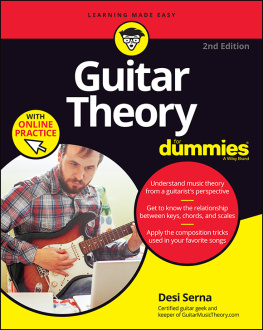
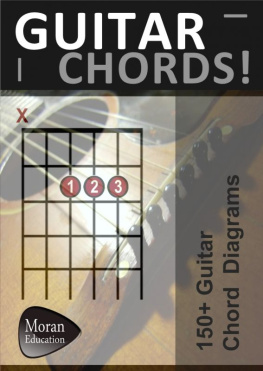
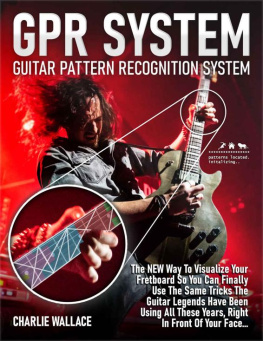
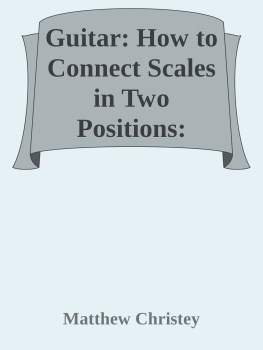
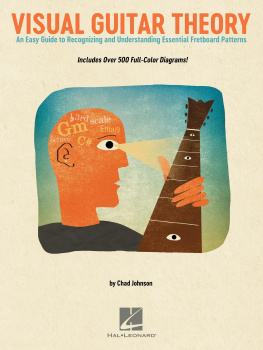
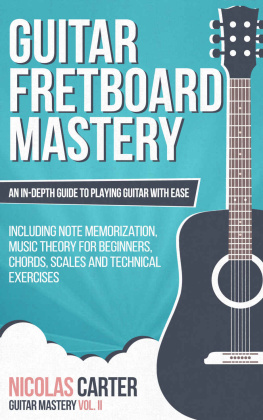
 Table of content What its all about The ascending guitarist will find everything necessary in this book, to come to an broad understanding of the fretboard of the guitar. It is highly recommended to be familiar with the basics of guitar playing, before working with this book. For the advanced beginner although, this book opens new doors and unlocks amazing ways to perceive the fretboard.
Table of content What its all about The ascending guitarist will find everything necessary in this book, to come to an broad understanding of the fretboard of the guitar. It is highly recommended to be familiar with the basics of guitar playing, before working with this book. For the advanced beginner although, this book opens new doors and unlocks amazing ways to perceive the fretboard. Exercise: Remember the tuning and fill in the notes in the graphic above. If you got the e-book version, take a piece of paper and a pencil. Roots
Exercise: Remember the tuning and fill in the notes in the graphic above. If you got the e-book version, take a piece of paper and a pencil. Roots From everyone of this notes, you can build a C major chord! Therefore, its very important, to know all the notes on the fretboard.
From everyone of this notes, you can build a C major chord! Therefore, its very important, to know all the notes on the fretboard. Here, we built a C major chord with the roots on the b-string and the a-string.
Here, we built a C major chord with the roots on the b-string and the a-string. By moving this chord three frets left, until the root is the a-string itself, we get the well known A major chord:
By moving this chord three frets left, until the root is the a-string itself, we get the well known A major chord:  So we deal here with the moved A major chord. But we built it on the root C so we get a C major chord. The next chord uses the roots on the g-string and e-strings:
So we deal here with the moved A major chord. But we built it on the root C so we get a C major chord. The next chord uses the roots on the g-string and e-strings:  By moving this chord to the head of the guitar, we get the G major chord:
By moving this chord to the head of the guitar, we get the G major chord:  So we deal here with the moved G major chord. But we built it on the root C, so we get C major. The next roots are found on the E-strings and the D-string.
So we deal here with the moved G major chord. But we built it on the root C, so we get C major. The next roots are found on the E-strings and the D-string.  Here we moved the E-chord:
Here we moved the E-chord:  But we build it on the root C, so we get C major.
But we build it on the root C, so we get C major. Here we deal with the moved D major chord.
Here we deal with the moved D major chord.  But we built it on the root C, so we get C major. Here is an overview, of all possible C major positions:
But we built it on the root C, so we get C major. Here is an overview, of all possible C major positions:  The same way we can handle minor chords. Again, we start with the root C and a chord that will be unfamiliar to most guitarists, but its easy to understand, where this chord is coming from. C minor, roots A-string and B-string This chord is tricky to grab, but its very good to know it!
The same way we can handle minor chords. Again, we start with the root C and a chord that will be unfamiliar to most guitarists, but its easy to understand, where this chord is coming from. C minor, roots A-string and B-string This chord is tricky to grab, but its very good to know it!  If we compare the C major with the C minor chord, we recognize, that only one note differs E becomes Eb.
If we compare the C major with the C minor chord, we recognize, that only one note differs E becomes Eb.  But we built it on the root of C, so we get C minor.
But we built it on the root of C, so we get C minor.